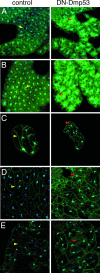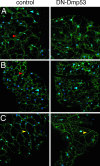Expression of dominant-negative Dmp53 in the adult fly brain inhibits insulin signaling
- PMID: 17686972
- PMCID: PMC1948898
- DOI: 10.1073/pnas.0706121104
Expression of dominant-negative Dmp53 in the adult fly brain inhibits insulin signaling
Abstract
In Drosophila melanogaster, p53 (Dmp53) is an important mediator of longevity. Expression of dominant-negative (DN) forms of Dmp53 in adult neurons, but not in muscle or fat body cells, extends lifespan. The lifespan of calorie-restricted flies is not further extended by simultaneously expressing DN-Dmp53 in the nervous system, indicating that a decrease in Dmp53 activity may be a part of the CR lifespan-extending pathway in flies. In this report, we show that selective expression of DN-Dmp53 in only the 14 insulin-producing cells (IPCs) in the brain extends lifespan to the same extent as expression in all neurons and this lifespan extension is not additive with CR. DN-Dmp53-dependent lifespan extension is accompanied by reduction of Drosophila insulin-like peptide 2 (dILP2) mRNA levels and reduced insulin signaling (IIS) in the fat body, which suggests that Dmp53 may affect lifespan by modulating insulin signaling in the fly.
Conflict of interest statement
The authors declare no conflict of interest.
Figures




Similar articles
-
Dominant-negative Dmp53 extends life span through the dTOR pathway in D. melanogaster.Mech Ageing Dev. 2010 Mar;131(3):193-201. doi: 10.1016/j.mad.2010.01.007. Epub 2010 Feb 1. Mech Ageing Dev. 2010. PMID: 20117129 Free PMC article.
-
dSir2 and Dmp53 interact to mediate aspects of CR-dependent lifespan extension in D. melanogaster.Aging (Albany NY). 2009 Jan;1(1):38-48. doi: 10.18632/aging.100001. Aging (Albany NY). 2009. PMID: 19851477 Free PMC article.
-
Chk2 regulates irradiation-induced, p53-mediated apoptosis in Drosophila.Proc Natl Acad Sci U S A. 2002 Aug 20;99(17):11305-10. doi: 10.1073/pnas.172382899. Epub 2002 Aug 9. Proc Natl Acad Sci U S A. 2002. PMID: 12172011 Free PMC article.
-
Guardian ancestry: fly p53 and damage-inducible apoptosis.Cell Death Differ. 2000 Nov;7(11):1035-8. doi: 10.1038/sj.cdd.4400766. Cell Death Differ. 2000. PMID: 11139275 Review.
-
P53 and Apoptosis in the Drosophila Model.Adv Exp Med Biol. 2019;1167:105-112. doi: 10.1007/978-3-030-23629-8_6. Adv Exp Med Biol. 2019. PMID: 31520351 Review.
Cited by
-
Organically grown food provides health benefits to Drosophila melanogaster.PLoS One. 2013;8(1):e52988. doi: 10.1371/journal.pone.0052988. Epub 2013 Jan 9. PLoS One. 2013. PMID: 23326371 Free PMC article.
-
Regulation of Drosophila Lifespan by bellwether Promoter Alleles.Sci Rep. 2017 Jun 23;7(1):4109. doi: 10.1038/s41598-017-04530-x. Sci Rep. 2017. PMID: 28646164 Free PMC article.
-
Drosophila Chk2 and p53 proteins induce stage-specific cell death independently during oogenesis.Apoptosis. 2010 Dec;15(12):1425-34. doi: 10.1007/s10495-010-0539-z. Apoptosis. 2010. PMID: 20838898 Free PMC article.
-
The progesterone antagonist mifepristone/RU486 blocks the negative effect on life span caused by mating in female Drosophila.Aging (Albany NY). 2015 Jan;7(1):53-69. doi: 10.18632/aging.100721. Aging (Albany NY). 2015. PMID: 25614682 Free PMC article.
-
Partial ablation of adult Drosophila insulin-producing neurons modulates glucose homeostasis and extends life span without insulin resistance.Cell Cycle. 2010 Aug 1;9(15):3063-71. doi: 10.4161/cc.9.15.12458. Epub 2010 Aug 20. Cell Cycle. 2010. PMID: 20699643 Free PMC article.
References
-
- Masoro EJ. Sci Aging Knowledge Environ. 2003:RE2. - PubMed
-
- Tatar M, Bartke A, Antebi A. Science. 2003;299:1346–1351. - PubMed
-
- Goberdhan DC, Wilson C. Differentiation. 2003;71:375–397. - PubMed
-
- Obsil T, Ghirlando R, Anderson DE, Hickman AB, Dyda F. Biochemistry. 2003;42:15264–15272. - PubMed
-
- Wang Y, Oh SW, Deplancke B, Luo J, Walhout AJ, Tissenbaum HA. Mech Ageing Dev. 2006;127:741–747. - PubMed
Publication types
MeSH terms
Substances
Grants and funding
LinkOut - more resources
Full Text Sources
Medical
Molecular Biology Databases
Research Materials
Miscellaneous

